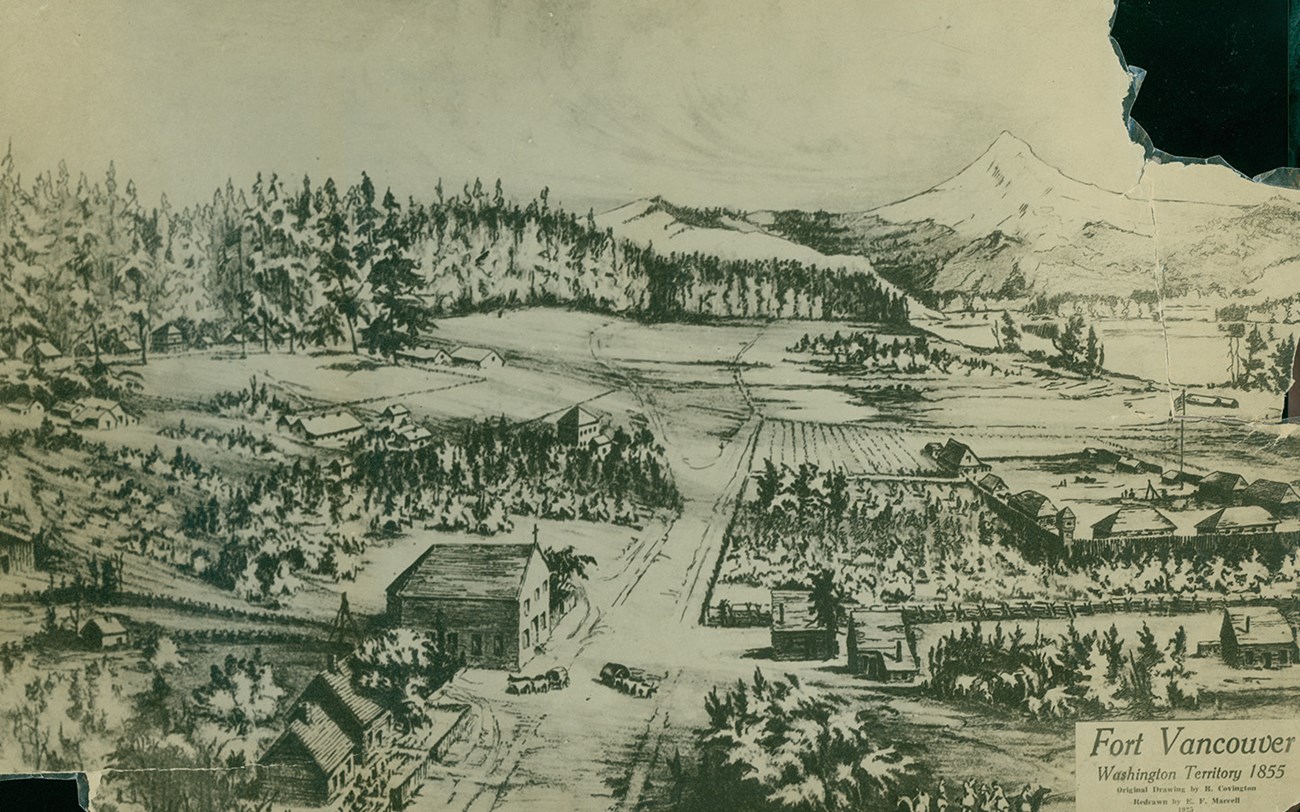Part of a series of articles titled Women's History in the Pacific West - Columbia-Pacific Northwest Collection.
Previous: Nez Perce Women and the War of 1877
Next: Wetxuwiis
Article

R. Covington photographer, Clark County Historical Museum, cchm00204
From the emerald shores of Ireland to the rustic beauty of Fort Vancouver, Catherine O’Byrne made her way halfway across the world to find her home. Born Catherine Murry on January 10, 1829, she left Ireland around the time that many others were doing the same.1 The Great Famine of the late 1840s irrevocably changed family structures in Ireland with drastic results for young women in particular. Potatoes had given generations the ability to provide for large families with relatively few resources. Massive death tolls and economic ruin from the famine left families with little to bequeath to their grown children. They resorted to male primogeniture, the right of succession to the firstborn male, to ensure that lands and parents would be cared for but this left single daughters to support themselves. Over four million Irish immigrated to the United States between 1847 and 1901, over half of them women.2
It is unknown what her travel conditions were like, whether she had any companions or family to ease her burdens, but O’Byrne would have arrived as one of many immigrants eager for work and facing the threat of poverty. Most young women her age chose to migrate to one of the major East Coast cities and take on domestic work, which gave them the opportunity to make steady wages, but left them open to abuse by employers.3 Murry chose to strike out West, migrating to California, where she met her future husband, Hugh O’Byrne. Hugh was a veteran of the US-Mexico War of 1846 to 1848. He fought for the United States, but many other Irish immigrants chose to fight on the Mexican side to escape ethnic and religious discrimination.
Once Hugh was honorably discharged from Company L of the 1st Artillery, the couple moved just outside of Vancouver Barracks in Clark County, Oregon Territory (in what would later become Washington Territory). The O’Byrnes gained a substantial amount of land through the Oregon Donation Land Law of 1850. This act allowed white men and their wives each to claim 320 acres of land, provided they improved upon the land for four years. Unfortunately, the land came at the expense of dispossessed Indigenous groups in the region. With the land they acquired, O’Byrne and her family became prominent farmers and a leading family in the area.4 They became members of a vibrant Irish Catholic community settling in Vancouver. Their daughter, Sarah, married Thomas W. Padden, a saloon owner from a large and well-respected Irish-immigrant family. Their other daughter, Maria Frances, helped to establish the St. James Catholic Church in Vancouver. O’Byrne would remain a pillar of her community until she was laid to rest next to her husband in the church her daughter helped establish on April 9, 1905.5
This project was made possible in part by a grant from the National Park Foundation.
This project was conducted in Partnership with the University of California Davis History Department through the Californian Cooperative Ecosystem Studies Unit, CA# P20AC00946
1 Ancestry.com. U.S., Find a Grave Index, 1600s-Current [database on-line]. Provo, UT, USA: Ancestry.com Operations, Inc., 2012.
2 Hasia R. Diner, Erin’s Daughters in America: Irish Immigrant Women in the Nineteenth Century (Baltimore: Johns Hopkins University Press, 1983), 28-31.
3 Margaret Lynch-Brennan, The Irish Bridget: Irish Immigrant Women in Domestic Service in America 1840-1930 (Syracuse: Syracuse University Press, 2009), 50.
4 Bradley D. Richardson, Gregory P. Shine and Marc J. Carpenter, “O’Byrne Military Discharge,” Fort Vancouver National Historic Site, National Park Service, last updated December 21, 2020, https://www.nps.gov/fova/learn/historyculture/people-in-the-hbc-era-1824-1860.htm
5 Year: 1900; Census Place: Vancouver, Clark, Washington; Page: 17; Enumeration District: 0029; FHL microfilm: 1241742
Part of a series of articles titled Women's History in the Pacific West - Columbia-Pacific Northwest Collection.
Previous: Nez Perce Women and the War of 1877
Next: Wetxuwiis
Last updated: March 23, 2022